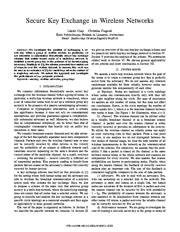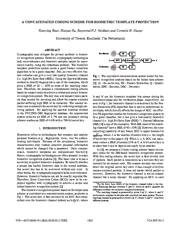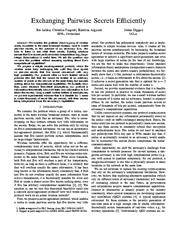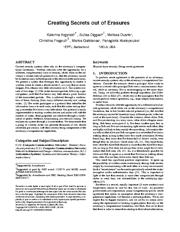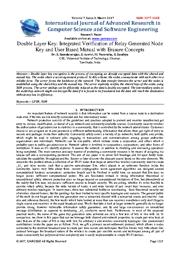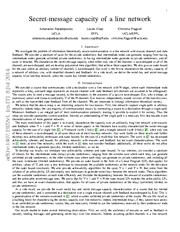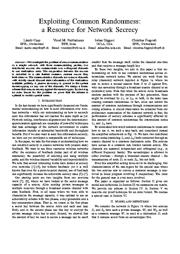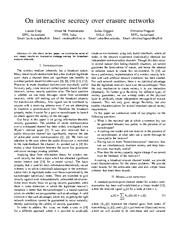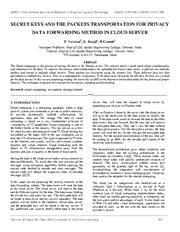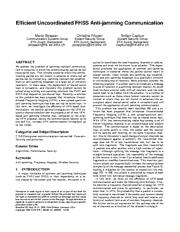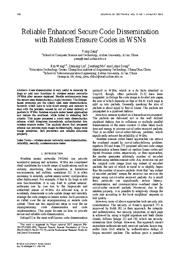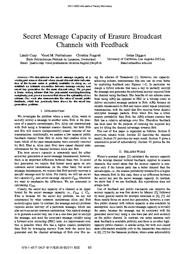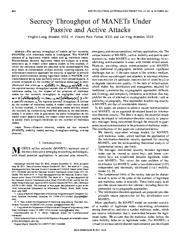A copy of this work was available on the public web and has been preserved in the Wayback Machine. The capture dates from 2017; you can also visit the original URL.
The file type is application/pdf.
Filters
Secure Key Exchange in Wireless Networks
2011
2011 International Symposium on Networking Coding
Similarly to [1], the scheme presented here makes use of erasures over the wireless channel. ...
We investigate the problem of exchanging a secret key within a group of wireless devices. ...
An appropriate number of linear combinations of the local keys are created to establish the secret group key. ...
doi:10.1109/isnetcod.2011.5978921
fatcat:qa5no4eodjfv5hb6qfzmkk7bfm
A concatenated coding scheme for biometric template protection
2012
2012 IEEE International Conference on Acoustics, Speech and Signal Processing (ICASSP)
The erasure decoder can reconstruct the secret key by collecting enough surviving packets. ...
The key idea is to transmit more packets than needed for decoding and allow the erasure-encoded packet suffering high BER to be discarded. ...
To figure out the secret key, the attacker needs to guess 2 N times, where N is the number of packets required in the erasure decoder. ...
doi:10.1109/icassp.2012.6288266
dblp:conf/icassp/ShaoXVS12
fatcat:eguetdit5rfkllydssjywlg54u
Exchanging Secrets without Using Cryptography
[article]
2012
arXiv
pre-print
We assume that the nodes initially share a (small) piece of information, but do not have access to any out-of-band channel. ...
can achieve a secret-generation rate of 38 Kbps. ...
Efficiency of secret agreement as a function of the erasure probability of the channels (assuming identical erasure channels) for our protocol (solid lines) and the alternative protocol (dashed lines). ...
arXiv:1105.4991v2
fatcat:yigvxrld3ffmtcxy2lcxzttwwm
Exchanging pairwise secrets efficiently
2013
2013 Proceedings IEEE INFOCOM
We consider the problem where a group of wireless nodes, connected to the same broadcast domain, want to create pairwise secrets, in the presence of an adversary Eve, who tries to listen in and steal these ...
Using a small wireless testbed of smartphones, we provide experimental evidence that it is feasible for 5 nodes to create thousands of secret bits per second, with their secrecy being independent from ...
In the particular example, these packets turn out not to be useful in creating the Alice/Bob secret, because Calvin knows both of them (and we want the secret to be unknown to Calvin). ...
doi:10.1109/infcom.2013.6567030
dblp:conf/infocom/SafakaFAD13
fatcat:dbwypcqqvbe3dfb7lh4eiv4i2e
Creating secrets out of erasures
2013
Proceedings of the 19th annual international conference on Mobile computing & networking - MobiCom '13
Our system consists of two steps: (1) The nodes transmit packets following a special pattern, such that Eve learns very little about a given fraction of the transmitted packets. ...
We present a system that leverages this opportunity to enable n wireless nodes to create a shared secret S, in a way that an eavesdropper, Eve, obtains very little information on S. ...
receivers that are in and out of the beam. ...
doi:10.1145/2500423.2500440
dblp:conf/mobicom/ArgyrakiDDFGK13
fatcat:6bks32o7prefrgonmqvg6coq4e
Double Layer Key: Integrated Verification of Relay Generated Node Key and User Based Mutual with Erasure Concepts
2017
International Journal of Advanced Research in Computer Science and Software Engineering
to create pair wise secrets and techniques that Eve knows very little about. ...
Our protocol leverages the broadcast nature of the wireless to create pair sensible secrets and techniques among all pair of nodes concurrently has polynomial time complexity and is easily implementable ...
CONCLUSION The two protocols for allowing a group of n wi-fi nodes to create pair wise secrets, inside the presence of a passive adversary, with restrained network presence, without assuming anything approximately ...
doi:10.23956/ijarcsse/v7i3/0160
fatcat:tdulcuc3ufhdbcwwpzva5nclwa
Secret message capacity of a line network
[article]
2014
arXiv
pre-print
We investigate the problem of information theoretically secure communication in a line network with erasure channels and state feedback. ...
As a side result, we derive the secret key and secret message capacity of an one-hop network, when the source has limited randomness. ...
So, doing time sharing between these two schemes can both create the maximum secret key and communicate the maximum amount of packets to the receiver. ...
arXiv:1407.1922v1
fatcat:tse5jvhks5expahbrv5bbjqega
Exploiting common randomness: A resource for network secrecy
2013
2013 IEEE Information Theory Workshop (ITW)
The communication channels are erasure channels with strictly causal channel state information of the destination available publicly. ...
A passive adversary is present in the system eavesdropping on any one of the channels. We design a linear scheme that ensures secrecy against the eavesdropper. ...
In other words, we take advantage of the fact that none of the eavesdroppers has received both packets X 1 and X 2 , to create a new packet both sources still have and is also secret from both eavesdroppers ...
doi:10.1109/itw.2013.6691232
dblp:conf/itw/CzapPDF13
fatcat:4r6mo7eszraorkskil6qehnoey
On interactive secrecy over erasure networks
2012
2012 5th International Symposium on Communications, Control and Signal Processing
In this short review paper we summarize some of our recent results on interactive message secrecy for broadcast erasure channels. ...
As pointed out in [4] this makes a clear distinction between the secret key generation and secret message sending problem. ...
This creates a erasure channel at every message level, with different erasure probabilities. ...
doi:10.1109/isccsp.2012.6217871
dblp:conf/isccsp/CzapPDF12
fatcat:tgi6pkacuzfujac4ubxjjz332u
SECRET KEYS AND THE PACKETS TRANSPORTATION FOR PRIVACY DATA FORWARDING METHOD IN CLOUD SERVER
2014
International Journal of Research in Engineering and Technology
In this we are proposing sending the secret key as SMS to the shared or forwarded nodes for the process of proper Security. ...
The Cloud computing is the process of storing the data in the Remote server. This process doesn't speak much about confidentiality and robustness of the data. ...
ACKNOWLEDGMENTS We thank our HOD and staff members of SRM University for guiding us throughout our research. ...
doi:10.15623/ijret.2014.0303065
fatcat:gmfdiyypbnhivasfj4ma4iljli
Efficient uncoordinated FHSS anti-jamming communication
2009
Proceedings of the tenth ACM international symposium on Mobile ad hoc networking and computing - MobiHoc '09
We address the problem of jamming-resistant communication in scenarios in which the communicating parties do not share secret keys. ...
In these cases, the deployment of shared secret keys is unrealistic, and therefore this problem cannot be solved using existing anti-jamming solutions like FHSS and DSSS that depend on pre-shared keys. ...
The attacker, in turn, blocks communication on c b out of c channels. ...
doi:10.1145/1530748.1530778
dblp:conf/mobihoc/StrasserPC09
fatcat:asf5vme7yzcedpvpl3i34m3zmu
Reliable Enhanced Secure Code Dissemination with Rateless Erasure Codes in WSNs
2014
Journal of Software
The Delugebased protocols are the widely used code disseminations, however, which have to take much energy and memory to deal with the problem caused by out of order delivery of packets in WSNs. ...
Rateless erasure codes based approaches can reduce the overhead, while failed in defeating DoS attacks. ...
However, the rateless erasure code can avoid the out-of-order problem. As a result they cannot take full advantage of erasure codes, and consequently does not immediately authenticate packets. ...
doi:10.4304/jsw.9.1.190-194
fatcat:wxcjxazczbho3pdsx56n2lytta
Secret message capacity of erasure broadcast channels with feedback
2011
2011 IEEE Information Theory Workshop
We characterize the secret message capacity of a wiretapped erasure channel where causal channel state information of the honest nodes is publicly available. ...
Our work also demonstrates the value of causal public feedback, which has previously been shown for the secret key generation problem. ...
Both Alice and Bob create the same n ((1 − δ)δ E − ) linear combinations of Bob's packets. ...
doi:10.1109/itw.2011.6089579
dblp:conf/itw/CzapPFD11
fatcat:hbqj7xw2krhd5mjgcpnycvwqqe
Secrecy Throughput of MANETs Under Passive and Active Attacks
2011
IEEE Transactions on Information Theory
Index Terms-Erasure channel, mobile ad hoc network (MANET), mobility model, secrecy, throughput scaling, wiretap channel. ...
A model under active attack is further studied, in which the malicious nodes actively attack the network by transmitting modified packets to the destination nodes. ...
To create an equivalent discrete memoryless erasure wiretap channel, we need to guarantee that symbols in one codeword (that encodes one message) see independent erasure channels. ...
doi:10.1109/tit.2011.2165800
fatcat:kwlsp4rabjbtdalnyvqhwiq7vu
Secure Capacity Region for Erasure Broadcast Channels with Feedback
[article]
2011
arXiv
pre-print
the packet erasure setting. ...
on the transmitted signals, and we can build on these differences with the help of feedback to create secret keys [9, 10] . ...
arXiv:1110.5741v1
fatcat:ec6y433psze5rolpxy6tkhantq
« Previous
Showing results 1 — 15 out of 1,099 results

